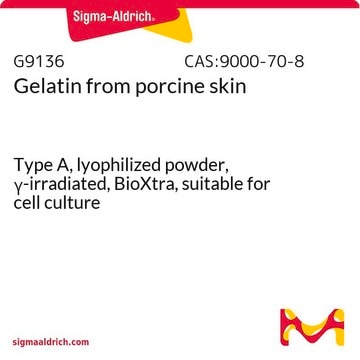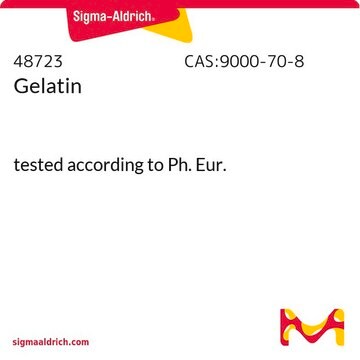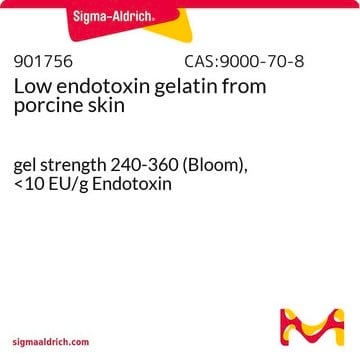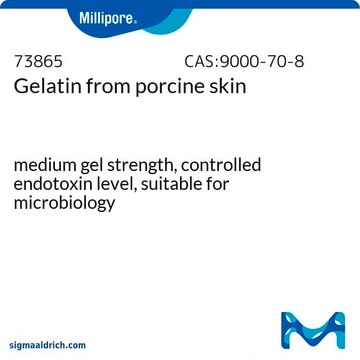G1890
Porcine Gelatin
from porcine skin, Type A, powder, gel strength ~300 g Bloom, suitable for electrophoresis and cell culture
About This Item
Polecane produkty
product name
Gelatin from porcine skin, powder, gel strength ~300 g Bloom, Type A, BioReagent, suitable for electrophoresis, suitable for cell culture
pochodzenie biologiczne
Porcine skin
sterylność
sterile
typ
Type A
linia produktu
BioReagent
Postać
powder
masa cząsteczkowa
50—100 kDa
opakowanie
pkg of 1 kg
pkg of 100 g
pkg of 500 g
stężenie
70—90% Biuret
metody
cell culture | mammalian: suitable
electrophoresis: suitable
pokrycie powierzchni
100‑200 μg/cm2
rozpuszczalność
H2O: soluble 50 mg/mL, clear to hazy, faintly yellow
Warunki transportu
ambient
temp. przechowywania
room temp
Szukasz podobnych produktów? Odwiedź Przewodnik dotyczący porównywania produktów
Powiązane kategorie
Opis ogólny
Zastosowanie
Cechy i korzyści
- Sterile gelatin sourced from porcine skin.
- Free from proteases.
- In the form of gelatin powder for convenient and easy handling.
- Versatile for use in cell culture and electrophoresis techniques.
- Provides adequate surface coverage for various applications.
Komponenty
Przestroga
Uwaga dotycząca przygotowania
Kod klasy składowania
11 - Combustible Solids
Klasa zagrożenia wodnego (WGK)
nwg
Temperatura zapłonu (°F)
Not applicable
Temperatura zapłonu (°C)
Not applicable
Środki ochrony indywidualnej
Eyeshields, Gloves, type N95 (US)
Certyfikaty analizy (CoA)
Poszukaj Certyfikaty analizy (CoA), wpisując numer partii/serii produktów. Numery serii i partii można znaleźć na etykiecie produktu po słowach „seria” lub „partia”.
Masz już ten produkt?
Dokumenty związane z niedawno zakupionymi produktami zostały zamieszczone w Bibliotece dokumentów.
Klienci oglądali również te produkty
Produkty
Discussion of synthetic modifications to gelatin, improving the three-dimensional (3D) print resolution, and resulting material properties.
The extracellular matrix (ECM) and its attachment factor components are discussed in this article in relation to their function in structural biology and their availability for in vitro applications.
Macierz zewnątrzkomórkowa (ECM) i jej składniki czynnika wiążącego są omówione w tym artykule w odniesieniu do ich funkcji w biologii strukturalnej i ich dostępności do zastosowań in vitro.
The extracellular matrix (ECM) is secreted by cells and surrounds them in tissues.
Protokoły
This gelatin coating protocol for cell culture applications offers information regarding types of gelatin, surface coverage concentration, and tips for optimization.
Ten protokół powlekania żelatyną do zastosowań w hodowli komórkowej zawiera informacje dotyczące rodzajów żelatyny, stężenia pokrycia powierzchni i wskazówki dotyczące optymalizacji.
Nasz zespół naukowców ma doświadczenie we wszystkich obszarach badań, w tym w naukach przyrodniczych, materiałoznawstwie, syntezie chemicznej, chromatografii, analityce i wielu innych dziedzinach.
Skontaktuj się z zespołem ds. pomocy technicznej














